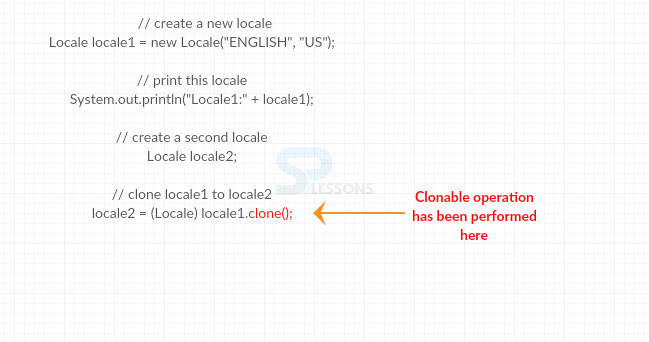 Description
Description
A locale is a course of action of parameters which addresses specific district, for instance, geographic region or political territory that has comparable lingo and conventions. A region challenge may consolidate customer's tongue, country, and any remarkable variety slants that customer needs. A Locale class which obliges operation to play out its endeavor is called as region touchy and uses Locale to offer information to the customer. Following is the syntax declaration for the
java.util Locale class.
[java]
public final class Locale
extends Object
implements Cloneable, Serializable
[/java]
 Constructors
Constructors
Following are the constructors of java.util Locale Class.
| Constructors | Description |
|---|---|
| Locale(String, String) | To build locale from language, country. |
| Locale(String, String, String) | To build locale from language, country, variant.. |
 Methods
Methods
Following are the methods of java.util Locale Class.
| Methods | Description |
|---|---|
| clone() | To override Cloneable |
| equals(Object) | To compare two objects for the purpose of equality. |
| getCountry() | To get the country code. |
| getDefault() | To get the default locale. |
| getDisplayName() | To get the name of locale. |
| getLanguage() | To get the language code. |
| getVariant() | To get variant code. |
 Description
Description
Following is the syntax declaration of the method.
[java]public Object clone()[/java]
DemoLocale.java
[java]
package com.SPlessons;
import java.util.*;
public class DemoLocale {
public static void main(String[] args) {
// create a new locale
Locale locale1 = new Locale("ENGLISH", "US");
// print this locale
System.out.println("Locale1:" + locale1);
// create a second locale
Locale locale2;
// clone locale1 to locale2
locale2 = (Locale) locale1.clone();
// print locale2
System.out.println("Locale2:" + locale2);
}
}
[/java]
The clone() method has been performed here.
Output: Now compile the code result will be as follows.
[java]
Locale1:english_US
Locale2:english_US
[/java]
 Description
Description
Following is the syntax declaration of the method.
[java]public boolean equals(Object obj)[/java]
DemoLocale.java
[java]
package com.SPlessons;
import java.util.*;
public class DemoLocale {
public static void main(String[] args) {
// create a new locale
Locale locale1 = new Locale("ENGLISH", "US");
// print this locale
System.out.println("Locale1:" + locale1);
// create a second locale
Locale locale2 = new Locale("GERMANY", "GERMAN");
// compare two locales
System.out.println("Locales are equal:" + locale1.equals(locale2));
// create a third locale
Locale locale3 = new Locale("ENGLISH", "US");
// compare locale1 and locale3
System.out.println("Locales are equal:" + locale1.equals(locale3));
}
}
[/java]
In the above example, there locale 1 and locale 2 have the same elements.
Output: Now compile the code result will be as follows.
[java]
Locale1:english_US
Locales are equal:false
Locales are equal:true
[/java]
 Description
Description
Following is the syntax declaration of the method.
[java]public static Locale getDefault()[/java]
DemoLocale.java
[java]
package com.SPlessons;
import java.util.*;
public class DemoLocale {
public static void main(String[] args) {
// create a new locale
Locale locale = Locale.getDefault();
// print the default locale
System.out.println("Locale:" + locale);
}
}
[/java]
The default locale of the system is going to be generated in the result.
Output: Now compile the code result will be as follows.
[java]
Locale:en_US
[/java]
 Description
Description
Following is the syntax declaration of the method.
[java]public String getLanguage()[/java]
DemoLocale.java
[java]
package com.SPlessons;
import java.util.*;
public class DemoLocale {
public static void main(String[] args) {
// create a new locale
Locale locale = new Locale("en", "US", "WIN");
// print locale
System.out.println("Locale:" + locale);
// get language and print it
System.out.println("Language:" + locale.getLanguage());
}
}
[/java]
Output: Now compile the code result will be as follows.
[java]
Locale:en1_US_WIN
Language:en1
[/java]
 Description
Description
Following is the syntax declaration of the method.
[java]public String getVariant()[/java]
DemoLocale.java
[java]
package com.SPlessons;
import java.util.*;
public class DemoLocale {
public static void main(String[] args) {
// create a new locale
Locale locale = new Locale("WIN", "US", "en");
// print locale
System.out.println("Locale:" + locale);
// get variant and print it
System.out.println("Language:" + locale.getVariant());
}
}
[/java]
Output: Now compile the code result will be as follows.
[java]
Locale:win_US_en
Language:en
[/java]
 Key Points
Key Points
- The
int hashCode()method is used to override hash code. - The
getISO3Language()method is used to return 3 letter abbreviation for the locale. - The
getDisplayLanguage()is utilized to give back the name for the locale.




